Operations Research (OR) is a field that helps make decisions using scientific methods. In the UK, it is called “Operational Research,” while Americans refer to it as “Operations Research.”
The term “OR” is often used for both. OR is closely related to “Management Science” (MS), and sometimes both terms are combined as “OR/MS.” It also overlaps with industrial engineering (IE) and decision science (DS).
OR is a relatively new discipline, and its boundaries are still being defined. At its core, OR applies mathematical and quantitative techniques to decision-making. Managers make decisions daily, but complex decisions often require more than just judgment or common sense.
Examples of complex decisions include planning a city’s public transport network or determining the best product mix for a company.
The key feature of OR is its focus on analyzing entire operations, unlike other research fields that focus on parts of systems.
OR emerged in World War II to improve military operations, but its success led to its use in business and industry. Today, OR is widely applied in various fields like inventory management, advertising policies, and warehouse location planning.
Different experts have defined OR and highlighted its focus on quantitative approaches and scientific methods for decision-making. For example:
- The Operational Research Society of Great Britain describes OR as a scientific approach to complex problems in management, incorporating measurements of factors like change and risk.
- Randy Robinson sees OR as applying scientific methods to improve operations and management.
- Morse and Kimball emphasize OR as a quantitative approach to executive decisions.
- Pocock views OR as a scientific methodology for better management decisions.
Table of contents
What is Operations Research?
Operations Research can be defined as a scientific approach to solving complex problems. It involves using quantitative methods to make decisions in various fields. Several definitions of O.R. have been given over the years, and they reflect the growth of the subject. Some prominent definitions include:
- Morse and Kimbal (1946): O.R. is a scientific method providing a quantitative basis for decisions.
- P.M.S. Blackett (1948): O.R. is a method offering an analytical and objective basis for decisions.
- Churchman, Acoff, Arnoff (1957): O.R. applies scientific methods to solve operational problems and provide optimal solutions.
- Jagjit Singh (1968): O.R. is a management activity combining creativity and established methods to make decisions.
From these definitions, a general and comprehensive definition is:
Operations Research is a branch of science that applies scientific methods and techniques to decision-making problems, aiming to find optimal solutions.
Characteristics of Operations Research (OR)
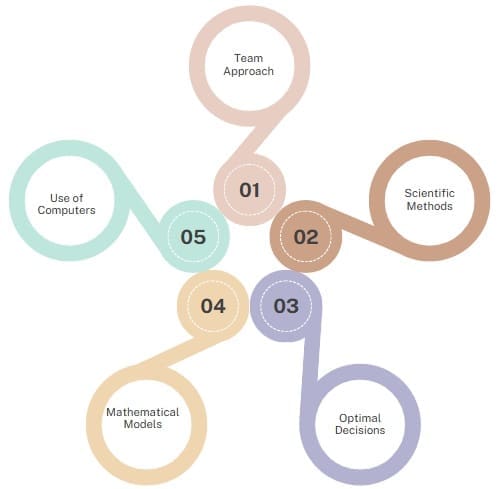
- Team Approach: OR is done by a team of scientists from different disciplines.
- Scientific Methods: OR uses scientific tools, techniques, and methods to solve problems. Tools are like cutting tools in a workshop. Techniques show how to use tools. Methods are plans to achieve goals using techniques.
- Optimal Decisions: OR helps executives make the best decisions.
- Mathematical Models: OR mainly relies on mathematical models for analysis.
- Use of Computers: OR heavily depends on computers to analyze these models.
Models in Operations Research
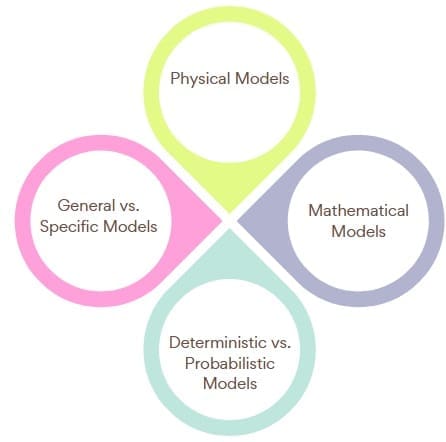
Physical Models: Diagrams, charts, and graphs that simplify problems.
Mathematical Models: Use mathematical symbols to represent decision variables.
Deterministic vs. Probabilistic Models: Deterministic models have clear results, while probabilistic models deal with uncertainty.
General vs. Specific Models: General models apply to many situations; specific models apply to particular problems.
History of Operations Research
OR started in the late 1930s, primarily in the UK. In 1936, the British Air Ministry established Bawdsey Research Station for radar experiments. The Royal Air Force (RAF) lacked effective aircraft, and radar data was not yet integrated into the air-defense system. This led to experiments that eventually gave birth to OR.
By 1939, OR teams played a significant role in improving the efficiency of Britain’s air-defense system. The RAF formalized the term “Operational Research” and used it to improve military operations. In 1941, OR was crucial in analyzing the loss of fighter aircraft during the Battle of Britain, helping save many planes for defense.
After World War II, OR expanded into business and industry. The U.S. National Research Council formed a committee on OR in 1951. By 1952, the Operations Research Society of America was established. Other countries, including India, adopted OR for military and industrial applications.
Stages of Development of Operations Research
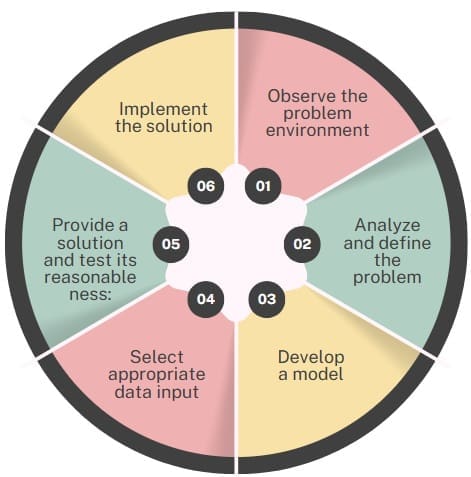
OR development follows six steps:
- Observe the problem environment: Gather information through conferences, site visits, and research.
- Analyze and define the problem: Understand the problem’s nature and objectives.
- Develop a model: Create a mathematical model that represents the system.
- Select appropriate data input: Collect relevant data for testing the model.
- Provide a solution and test its reasonableness: Use the model to find a solution and check its validity.
- Implement the solution: Apply the solution, considering behavioral and management issues.
Also Read: Lean Six Sigma Certification Programs, Norfolk, Virginia
Key Tools and Techniques
Linear Programming: Optimizes an objective (e.g., profit) within constraints.
Game Theory: Helps make decisions in competitive situations with conflicting interests.
Decision Theory: Focuses on making decisions under certainty or probability.
Queuing Theory: Minimizes waiting costs, balancing service and waiting costs.
Inventory Models: Reduce total costs by managing inventory efficiently.
Simulation: Tests solutions using trials when real-world testing is impractical.
Non-linear Programming: Solves problems with non-linear relationships.
Dynamic Programming: Analyzes multi-stage decisions with interdependent steps.
Integer Programming: Solves problems requiring integer values (e.g., number of items).
Markov Process: Predicts future states based on current information.
Network Scheduling: Plans and monitors large projects, using methods like PERT and CPM.
O.R. Problem-Solving Process
Identify the Problem: Recognize the symptoms and define key variables.
- Model the Problem: State the problem quantitatively.
- Choose Tools: Select appropriate techniques for solving the problem.
- Generate Solutions: Explore alternatives and test them.
- Evaluate Solutions: Assess which solution fits the organizational constraints.
Relationship Between the Manager and OR Specialist
Managers make decisions, and OR specialists help them make better ones. The OR specialist uses scientific methods to provide insights, models, and data that guide the manager’s decisions.
Advantages of Operations Research
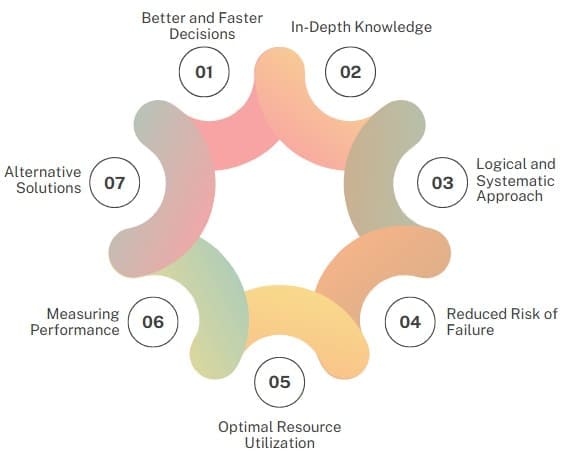
O.R. provides several benefits to decision-makers, including:
- Better and Faster Decisions: O.R. allows decision-makers to evaluate different alternatives and assess risks quickly. This leads to more informed and effective decisions.
- In-Depth Knowledge: O.R. helps in preparing future managers by providing a systematic approach to problem-solving.
- Logical and Systematic Approach: The models developed in O.R. provide a structured method to understand, solve, and control problems efficiently.
- Reduced Risk of Failure: O.R. offers multiple alternatives to a problem, helping managers choose the best option. It also allows evaluation of potential risks for each solution.
- Optimal Resource Utilization: O.R. techniques, such as linear programming, help in using resources most effectively, ensuring that costs are minimized and outputs are maximized.
- Measuring Performance: O.R. helps in setting performance standards and comparing employee performance against these benchmarks. It provides data for making improvements.
- Alternative Solutions: O.R. offers several solutions to the same problem, giving management the flexibility to choose based on changing circumstances.
Limitations of Operations Research
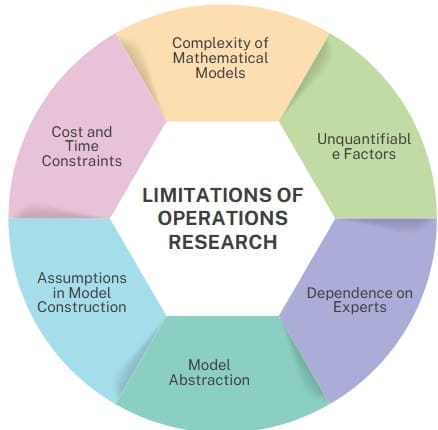
Despite its many advantages, O.R. also has some limitations:
- Complexity of Mathematical Models: Formulating mathematical models can be challenging, as it requires considering all possible factors. This can lead to complicated computations, which may require the use of computers, making O.R. techniques less accessible for smaller organizations.
- Unquantifiable Factors: Some problems involve intangible factors like human emotions or relationships, which are difficult to quantify. As a result, O.R. may not always provide the best solution when these factors are significant.
- Dependence on Experts: O.R. requires specialists such as mathematicians or statisticians to formulate models and interpret results. Managers without expertise may struggle to understand the models, which could result in suboptimal solutions.
- Model Abstraction: Models used in O.R. are simplifications of real-life situations. They do not always capture the full complexity of the problem, and the solutions may not fully reflect reality.
- Assumptions in Model Construction: Building an O.R. model often requires making assumptions about the importance of certain factors. These assumptions may not always align with real-world conditions.
- Cost and Time Constraints: O.R. can be expensive and time-consuming. In some cases, management may prefer a simpler solution that requires less investment, even if it is not the optimal solution.
Final Words
Operations Research is a powerful tool for improving decision-making and solving complex problems. Its techniques are applied across a wide range of industries, including agriculture, defense, finance, marketing, personnel management, and more. O.R. helps managers make better, faster decisions by providing a structured, analytical approach to problem-solving.
Despite its limitations, O.R. continues to evolve and remains a vital discipline in both academic and practical settings. As technology advances, the scope of O.R. is likely to expand, offering even more ways to optimize operations and improve efficiency across various sectors.

About Six Sigma Development Solutions, Inc.
Six Sigma Development Solutions, Inc. offers onsite, public, and virtual Lean Six Sigma certification training. We are an Accredited Training Organization by the IASSC (International Association of Six Sigma Certification). We offer Lean Six Sigma Green Belt, Black Belt, and Yellow Belt, as well as LEAN certifications.
Book a Call and Let us know how we can help meet your training needs.

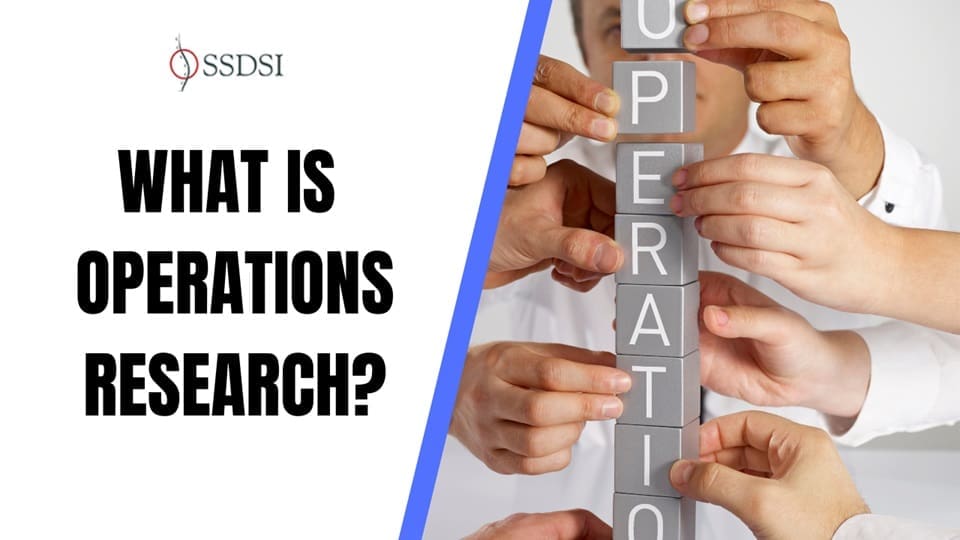










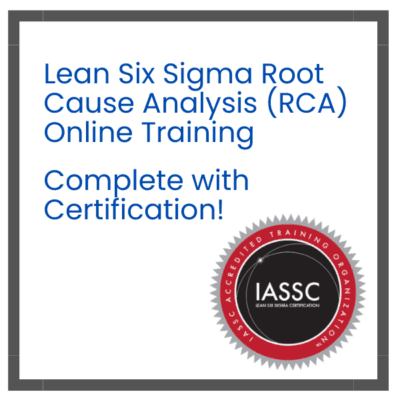

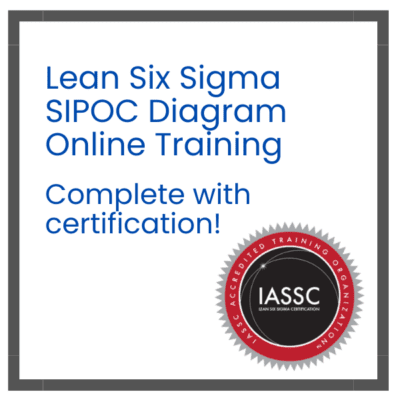
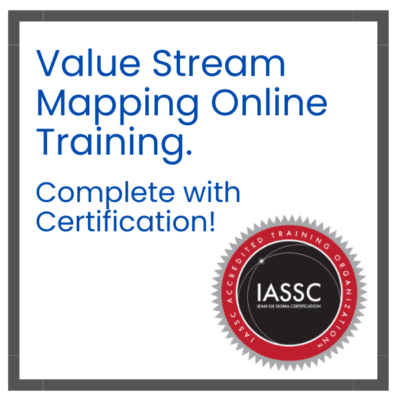
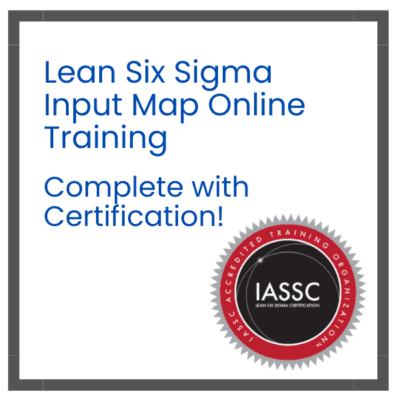
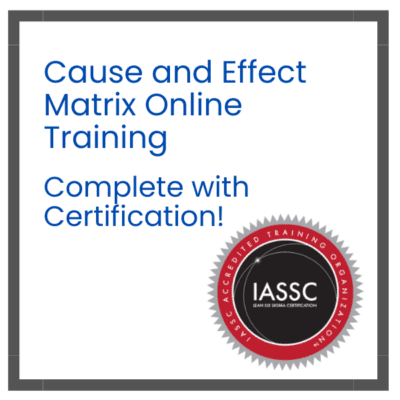


I have achieved Black Belt from Sux Sigma Academy Amsterdam.
I am doing R&D in a concrete block manufacturing factory.
Also acting as a trainer on Lean Manufacturing techniques.
How I can attached with your organisation to know the best practices and case studies of Lean Manufacturing techniques and lean six sigma.Thanks
Syed Mahfuz Ahmad, Good afternoon. Join our email list to know best practices and case studies on LEAN techniques: https://lp.constantcontactpages.com/su/jVxw0LU.